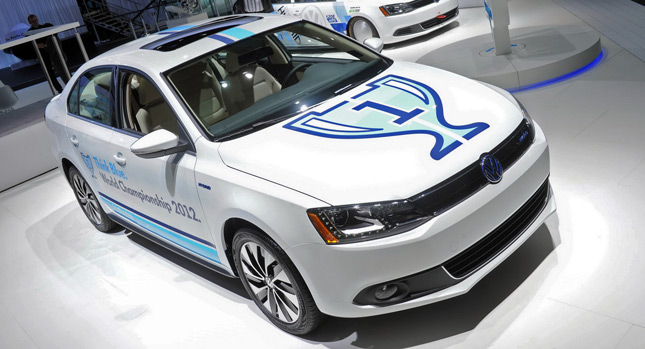The hybrid version of VW’s Jetta compact saloon was displayed as a concept in January’s Detroit Auto Show and it has already been announced that it will go on sale in the States before the end of the year as a 2013 model, with prices starting at US$24,995 excluding a destination charge of US$795.
It was about time, then, to introduce the final production version of the Jetta Hybrid to the U.S. market – and VW promptly did that at the LA Auto Show.
VW’s second U.S. hybrid after the Touareg is powered by a 1.4-liter turbocharged gasoline TSI engine with direct injection that has an output of 147HP and 184 lb-ft (250 Nm) of torque mated to a 20 kW (27HP) electric motor.
A decoupling clutch integrated between the two drives disengages the internal combustion engine when necessary, while a 7-speed dual-clutch DSG transmission transfers power to the front wheels.
The 60-cell, 1.1 kWh lithium-ion battery pack weighs just 35.8 kg (78 pounds) and, thanks to its compact dimensions, is integrated behind the rear seats resulting in no compromise in space. It has its own management system that performs diagnostic, safety and temperature controls and, when needed, actuates a cooling fan than ensures the battery operates within its optimal parameters.
Very much like the Touareg, the Jetta is a parallel hybrid. It can operate on electric power alone for a distance up to 1.3 miles (2 km) either automatically (up to 37 mph – 60 km/h) or manually, by pressing the E-mode button next to the gear lever (up to 44 mph – 70 km/h).
The difference with other hybrid systems is in that during zero-emission, all-electric operation not only is the TSI gasoline engine stopped but, thanks to the decoupling clutch, it’s also completely disengaged from the drivetrain, further minimizing friction losses thus improving efficiency.
The TSI engine is also shut off and disengaged when the driver releases the accelerator pedal at speeds up to 84 mph (135 km/h), allowing the Jetta Hybrid to cruise with zero fuel consumption.
The Jetta Hybrid can also be operated using the gasoline engine alone when the driver goes for it or the battery is discharged. When the gear lever is in the “S” position or the manual gate, then both the TSI and the E-motor work together to produce a maximum output of 167HP, accelerating the Jetta from 0-60 mph (0-96 km/h) n less than 9 seconds. At the same time, its combined fuel economy is rated at 45 mpg US (5.2 lt/100 km), which according to VW, is 20 percent better than a conventionally powered car of the same size.
Standard specification in all models includes front, side and window airbags, ABS and ESP, with read side airbags being optional. The base SE version gets LED rear lights and low rolling resistance all-season tires. The SE with upgraded interior trim features a leather steering wheel, “Titan black” or “EcoTech” seat upholstery, a two-zone automatic climate control, a trip computer, a Premium 8 audio system and Bluetooth cell-phone as well as iPod connectivity.
The SEL1 trim level add features such as a navigation system, keyless entry and engine start, heated front seats with electric adjustment on the driver’s side, a sunroof and 16-inch alloys.
Those opting for the top SEL2 version also get bi-xenon headlights with cornering function, fog lights, 17-inch alloy wheels, a reversing camera and a 400-Watt Fender audio system.
By Andrew Tsaousis
PHOTO GALLERY




















